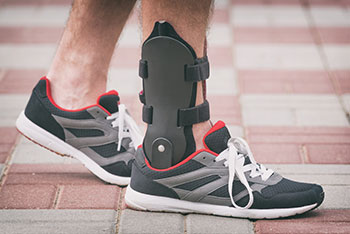Sports Bracing: Money Well Spent?

Sports bracing is a multi-billion dollar industry. We are inundated with sports bracing options. As we progress in our athletic endeavors, at some point bracing and/or taping will be thrust upon us. Usually a multitude of questions will ensue. Do the braces really work? Will it help my performance? Will it prevent injury? Will it strengthen my extremity? Should I do it, because it appears everyone else is? Are there other options? As with most medical issues the answers to these questions, depend on whom you're asking them. Is it your coach, your teammate, your trainer, your doctor, a brace company representative, or a salesman at the local sporting goods store? The answers will likely be different from each of these sources.
In general, if you think of the highest level athletes performing at their peak, they are very rarely encumbered by braces. Their bodies are chiseled, well-oiled machines. Strong and sleek. If these athletes were required to wear a brace, one would wonder if they would perform as well. Most of these athletes would refuse bracing for fear of a drop in their performance. Hence, the best case scenario would be to maintain superior sports fitness to avoid injury and to maintain performance.
To answer some of the bracing questions, one should understand clearly what braces can not do. They can not replace your muscles, or make you stronger. They can not improve your skill or make you faster. Strength, skill and speed are elements of athleticism that must be fostered through repetitive training and practice. Training and practice are the primary keys to injury prevention.
How do braces work? They provide structural support to joints in planes in which the joint should have its own structural support, but in many cases the natural support has been weakened, i.e. by injury. Some braces are just sleeves that simply provide warmth and compression to a joint, without truly improving structural stability. As such, braces either function to improve structural stability, or they simply provide comfort and padding.
How does taping work? Taping a joint provides additional support to surrounding ligaments. The support comes from the mechanical properties of the tape used. Unfortunately, these properties degrade quickly with movement and exertion, such that studies have proven that taping may help structurally for only approximately 10 - 15 minutes after application. Many injuries do occur within the first 10 minutes of sporting activities, so taping does provide a finite benefit. If re-taping occurs at half-time, or at periods during the game, then protection can be increased. Taping done incorrectly can lead to pain, numbness, blisters, and circulation problems.
Providing comfort and padding is usually a reasonable option for a troublesome joint, with little detriment to performance. But adding structural stability comes at a price. These braces tend to be bulkier, and more cumbersome. As well, if the fit is not perfect, they will not function as advertised, and can actually lead to injury or problems. In the young athlete, the increased weight on the extremity may be just enough to throw off body mechanics, such that other problems may ensue.
Bracing your young athlete should be carefully considered with your sports specialist. A sports specialist will usually involve a physical therapist and an orthotist, or orthotics specialist, prior to placing the athlete in a brace. Physical therapy provides the training needed to prevent re-injury and eventually return to brace free performance, which should be the ultimate goal. If a brace is selected as an option, the orthotics specialist will ensure proper fitting and education on the brace, to maximize its usefulness. In many cases, bracing will only be a temporary necessity, until therapy can be completed, and strength, balance and flexibility restored to optimum status. Taping an athlete should be done initially by a sports trainer, so that proper techniques can be used, and the athlete educated on self-taping.







